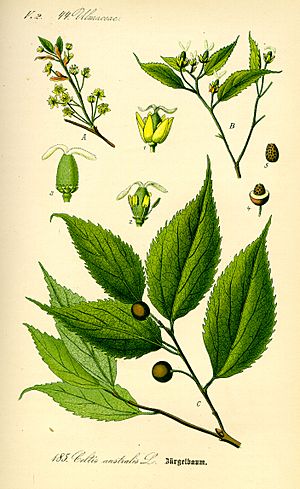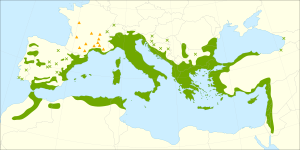European nettle tree facts for kids
Quick facts for kids European nettle tree |
|
|---|---|
 |
|
| Celtis australis | |
| Scientific classification | |
| Genus: |
Celtis
|
| Species: |
australis
|
 |
|
| Distribution map | |
The European nettle tree (scientific name: Celtis australis) is a cool tree that loses its leaves in autumn, just like many trees do. It's also called the Mediterranean hackberry, lote tree, or honeyberry. You can find it naturally growing in places like Southern Europe, North Africa, and parts of Asia. It was first brought to England in 1796.
Contents
What Does the European Nettle Tree Look Like?
This tree can grow quite tall, sometimes up to 25 meters (about 82 feet), which is like a seven-story building! But in colder places, it's usually around 10 meters (33 feet) tall. Its bark is smooth and grey, often looking a bit like an elephant's skin.
The leaves grow in an alternating pattern along the branches. They are long and narrow, with sharp teeth along the edges. The top of the leaves feels rough, while the bottom is soft and fuzzy. They are about 5 to 15 centimeters (2-6 inches) long and stay a dark grey-green color most of the year. In autumn, they turn a light yellow before falling off.
The flowers of the European nettle tree are small and green. They don't have petals and are pollinated by the wind. These flowers are special because they are "perfect," meaning each flower has both male and female parts. They grow either alone or in small groups.
The fruit is a small, dark-purple berry, about 1 centimeter (0.4 inches) wide. It's a type of fruit called a drupe, which means it has a fleshy outside and a hard pit inside, like a cherry or a peach. These fruits hang in small bunches and are edible. Birds and other animals love to eat them!
-
A European nettle tree in Panchkhal VDC, Nepal.
History and Uses of the Nettle Tree
People believe that the European nettle tree might be the famous "Lotus" tree from ancient stories. Writers like Herodotus, Dioscorides, and Theophrastus described its fruit as sweet and healthy. In Homer's epic poem Odyssey, the hero Ulysses meets the "Lotus-eaters" who eat a fruit that makes them forget their homes. This fruit is thought to be from the nettle tree.
The European nettle tree is often planted in towns and cities because it lives a long time and can handle air pollution well.
Its sweet fruit is safe to eat, either raw or cooked. In traditional medicine, the leaves and fruit were used to help with various tummy troubles. People also used a yellow dye made from the tree's bark. The wood of the nettle tree is very strong and flexible. It's often used by people who turn wood on a lathe, and its thin, bendy branches can even be made into walking sticks.
How to Grow the European Nettle Tree
This tree likes sunny spots with soil that drains well, like sandy or loamy soil. It can even grow in soil that doesn't have many nutrients. The European nettle tree can handle dry weather but doesn't like too much shade. It grows best in a Mediterranean climate, which has warm, dry summers and mild, wet winters. However, it can also survive in colder areas. An old book from the 12th century, Book on Agriculture by Ibn al-'Awwam, even has tips on how to grow this tree!
Common Names Around the World
The European nettle tree has many different names in various countries:
- Albanian: carac, Kaliboba;
- Arabic: الميس (mays);
- Bulgarian: копривка;
- Catalan: lledoner;
- Croatian: koprivić, obični koprivić, ladonja, farikul, fafarikula, pelegrinka, kostela, kostjela, koštela, košćela, koščela crna;
- English: the honeyberry tree, European hackberry, hackberry, nettle tree, Mediterranean hackberry;
- French: micocoulier;
- German: Zürgelbaum;
- Hebrew: מיש (mayish)
- Hindi: ku, batkar, khark, khirk, roku;
- Italian: perlaro, bagolaro;
- Kashmiri: Brimij
- Montenegrin: košćela;
- Nepali: khari;
- Polish: wiązowiec południowy
- Portuguese: lódão-bastardo, lodoeiro, ginginha-do-rei, agreira;
- Romanian: sâmbovină
- Slovenian: koprivovec;
- Spanish: almez, lodón, ladón, ojaranzo, hojaranzo;
- Turkish: adi çitlembik;
- Kurdish: Taug (تاوگ) ;
Some trade names for its wood are nettle wood and brimji.
Famous European Nettle Trees
There's a very old and large European nettle tree planted in 1550 in front of a church in the village of Fox-Amphoux in southern France. In 2013, this tree was 18 meters (59 feet) tall, and its trunk was 5 meters (16 feet) around!
In some traditions, hackberry trees are seen as holy. People used to make special charms from their wood to ward off bad spirits. The hackberry trees on the Temple Mount in Jerusalem are believed to be some of the oldest in the world.
The fruit of the lotus tree and its effects are also mentioned in the famous poem The Lotos-Eaters by Tennyson.
See also
 In Spanish: Lodón para niños
In Spanish: Lodón para niños






